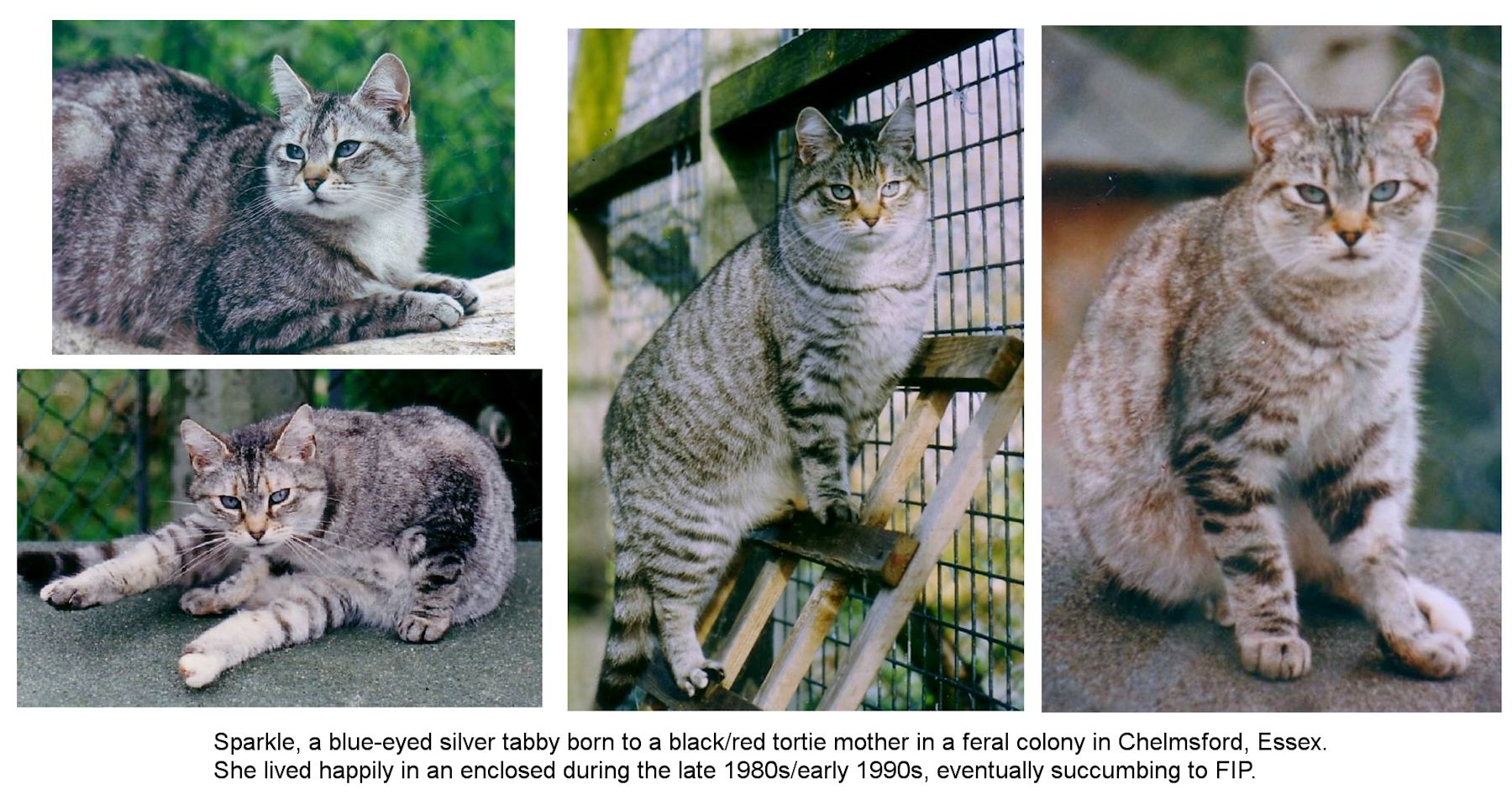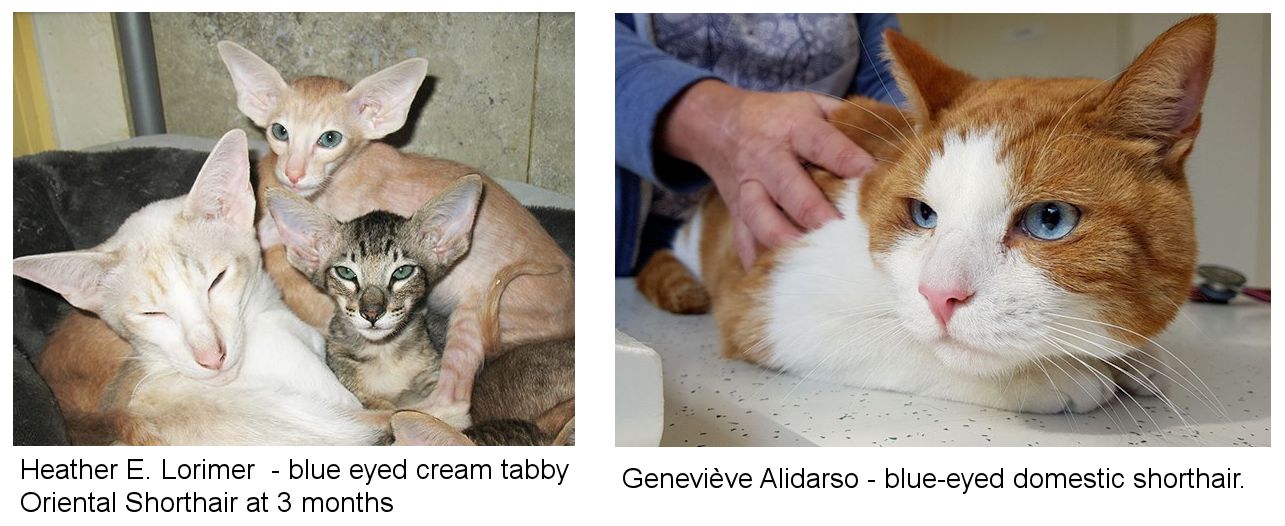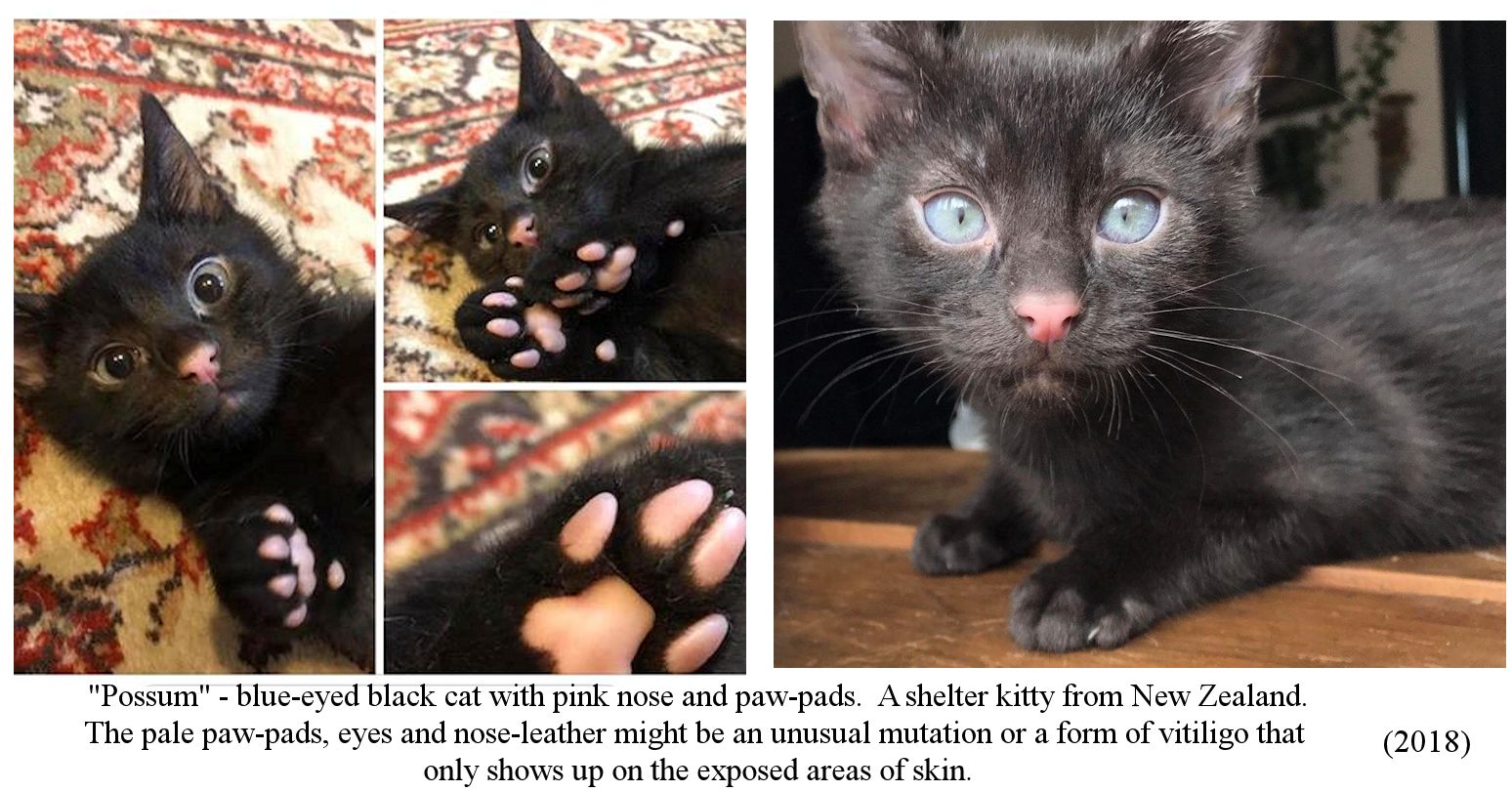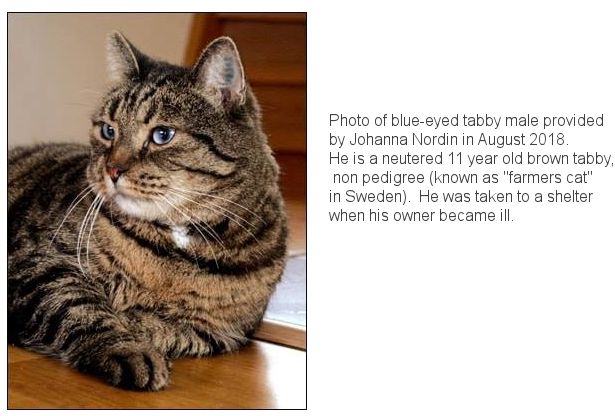
BLUE-EYED BREEDS / DOMINANT BLUE EYE (DBE)
Blue-Eyed Breeds 1 - Altai, Topaz, Barnaul, American Ojos Azules, Topaz etc
Blue-Eyed Breeds 2 (this page) - Spontaneous Blue-eye Mutations in Australian cats, Chinese cats, Historical Reports.
Reviewing the Dominant Blue Eye Gene in the Ermine Trace Cattery (Elizabeth Lipovenko)
OTHER BLUE-EYED CATS & HISTORICAL REPORTS
The blue-eyed trait turns up surprisingly often in random-breeding cats, and occasionally in pedigree cats through random mutation.
One of the earliest historical reports of "permanently blue-eyed cats" can be found in the Cat Gossip column of The Ladies' Field, July 8, 1905, pg 187: AN item of news which appears in a contemporary is of much interest. Mr. Godfrey Shaw states that a tabby queen he used to own, weighing about 3 lb., is, he is told, always throwing kittens of varied colours with permanently blue eyes. Mr. Shaw, not quite believing this, has persuaded the owner to save a kitten from her last litter, and this, a sandy tom, has, at the age of three weeks, brilliant blue eyes. It will be most interesting to hear if they remain so.
Anpther early report is that of "BLUE-EYED MOLLIE" in the London Daily News, 23rd July 1920: Have you ever seen a black cat with blue eyes? Notice all the black cats to-day and you will find they have yellow or orange coloured eyes. Women who prided themselves on their knowledge of cats threw up their hands when they saw Blue-Eyed Mollie at the Croydon Cat Show yesterday. She is a wonderful animal with forget-me-not eyes and mysterious pedigree. She was variously described as a freak, a feline phenomenon, rarer than a white-face n*gger, and the only cat of her kind in the world. . . . She was exhibited by Miss F. Moore. Blue-Eyed Mollie was asleep when a Daily News representative called on her at No. 122 in the Show, and it was necessary to wake her to see the colour of her eyes. When she opened them the effect was almost startling, unreal; she looked like a toy black cat with glass eyes of blue that were meant for a fair-haired doll. She is not a kitten, but is shown in the short-hair adult class over nine months. This strange blending of black and blue made a great impression on Sir Claud Alexander, who visited the show as judge, and she was awarded a prize.

Below: silver tabby female feral cat, black-and-white male, red tabby (with white bib) male, red tabby longhair male, odd-eyed tortie, black-and-white male.


Wain Harding, Secretary Egyptian Mau Breeders & Fanciers Association (May 1971 Cats Magazine): "I was very interested in your recent article The Cat That Couldn't Be Bred' by Mrs. Sayer. The Egyptian Mau breeders have recently had four blue-eyed kittens from different parents. These kittens are beautiful well spotted, silver Mau with deep blue eyes. All of these kittens share a common grand or great-grand parent (Kattiwyckes Gulliver x Kattiwyckes Trinket owned by Mrs. Ann Cahill). The first of these blue-eyed beauties appeared in one of my own litters (Kattiwyckes Umm Usada bred to her son Bast's Zosser). I kept waiting for this kittens eyes to change as it is often four months before a Mau kitten's eyes change from blue to the desired gold. I exhibited Chui Chali at the Fall Baltimore CFA show when he was six months old. I still insisted that his eyes would change to the admiring public. The kitten's eyes never changed and he grew up and sired a litter now nine days old. We are anxiously waiting for the kittens to mature.
The second kitten appeared in a litter of Ann Cahill's breeding. This beautiful young female, Kattiwyckes Dynamite, will soon be bred to Bast's Chui in the hopes of producing an all blue-eyed litter. The third blue-eyed baby appeared in a litter of kittens bred by Barbara Abruzzo of New Jersey. The fourth kitten appeared in a litter bred by Joan Dewberry of Ta-Mera Cattery in California. We are very proud of our blue-eyed stock and have great expectations for these kittens. The most plausible explanation for the blue-eyed mutation has to do with the amount of inbreeding that has been necessary to keep the Egyptian Mau the pure, natural breed it was upon importation. Bast Chui Chali is now at stud to Egyptian Mau queens of pure ancestry as well as to approved Foreign Short- hair breeders interested in breeding a foreign type cat with blue eyes. We are helping a breeder develop blue-eyed blacks at the present time. The Egyptian Mau Breeders and Fanciers Association are happy to announce blue eyed Mau kittens and gene-carriers in the near future."
In Cats Magazine. October 1972, Mrs. Dagmar Thies, from W. Germany wrote: "From an American cat-breeder, I recently heard that it would be possible to breed blue-eyed Black Foreign Shorthairs. We are breeding these wonderfully charming cats, Calling them "Ebonies." After three generations of back-crossing self-coloureds to best typed Siamese we started mating Black to Black, and now we have the third generation of Ebonies. Two of our queens, one second and one third generation self-bred, are showing very light blue-green eye colour, without any yellowish glimmer. Would it be possible to reach blue-eyed kittens by back-crossing them to Siamese once more? Do you think that blue eyed Blacks would be worth breeding?"
Don Shaw (Cats Magazine's resident geneticist) answered: "Your letter is most informative. The enclosed photographs were excellent. You have truly obtained, the Foreign Shorthair type in your Ebonies. In answer to your question; there is no genetic evidence to my knowledge which would suggest that the genic factors for blue-eyedness in self-colored cats can be obtained by crosses with Siamese. All the data thus far examined by us, indicate that the basic causative genic factor for blue eyedness in Siamese is intrinsic to the "cs" allele which is responsible for the temperature sensitivity color-point affect. If this is indeed the case, then this genic factor must be eliminated if you hope to obtain true breeding self-colored cats. From the information at hand, it is very likely that the two queens you described may have picked up eye color factors from the self-colored cats in their background which may or may not be being amplified by the "cs" allele, which could still be heterozygous in these particular, cats. No, I do not think that crosses with Siamese would either help you toward blue-eyed black nor would it help you toward your goal of true breeding Ebonies. Are blue-eyed Blacks worth breeding? Yes, from a genetic point of view they would provide us with entirely new concepts concerning eye color. Over the years I have heard reports of truly blue-eyed Blacks, but in my ten years of searching I have not come up with one valid case. Somehow, people say they have had them or have seen them, but when I go to examine the cat it is not there, or the eyes are green. They may be bluish-green, but nonetheless they are green, not truly blue as we get in Siamese and Blue-Eyed Whites. From a sales view point, I can assure you there would be a market in this country and I strongly suspect the market would be world-wide."


In Cats Magazine July 1973, Elaine Brenna wrote: I read with interest your remarks in the March [issue] about the rarity of blue-eyed black cats. I am not a breeder of cats although I have two, and a picture of one is enclosed. As you can see Tosca's eyes are quite blue; there is no camera distortion here. He is also black, but not quite jet black. This picture was taken when he was about four months old; he's now six months old and has matured quite a bit. He has not been altered. His eye color is still the same and his coat has taken on a glossy, sleek appearance. He resembles a Burmese quite strongly except for his eye and coat color. Tosca is quite intelligent and makes a wide variety of sounds. He does have one white patch on his lower abdomen. Whether your article was referring to Blue-Eyed Persians that are black or just blue-eyed black cats in general I don't know. I thought I'd send this on to you for information purposes only. Tosca's origin is unknown."
Don Shaw (Cats Magazine's resident geneticist) answered: We greatly appreciated the information and picture of the "blue-eyed black." Unfortunately, we cannot reproduce the picture, but according to the photograph, Tosca does indeed have blue-eyes. In fact, they are a fantastic blue. If, as you say, there is no camera distortion, they might be called royal blue - it is virtually unbelievable! The closest thing to this eye color I have ever seen is a deep violet blue which can be traced back to a particular Siamese line. A similar deep blue is relatively common in very young kittens right after they open their eyes, but this generally changes by four months and certainly by six months. If they are still this fantastic blue at eight months, we at CATS would seriously consider publishing a color photograph if you could obtain a good sharp color transparency with neutral background. That blue-eye coloring would be overwhelming on a cat of any color. >Now to the genetics you state that there is "one white patch on his lower abdomen: "This would indicate that he is carrying the pied, white-spotting S-allele. Am I seeing things, or is, it camera distortion, or is there really a tiny cluster of white hair at the inner edge of the left eye near the bridge of the nose? Also please examine his toe nails are they all showing darkish marrow? If this blue-eye coloring remains, you may well have an excellent example of the S-allele's producing blue-eye with very little indication of its manifestation in producing white-spotting."
A grey bicolour (tuxedo pattern) cat with intense sapphire blue eyes was found on a country road in Windellama, New South Wales, Australia by A M Schnieder. Since the Ojos Azules was never imported into Australia, this appears to be a spontaneous mutation among the feral population.